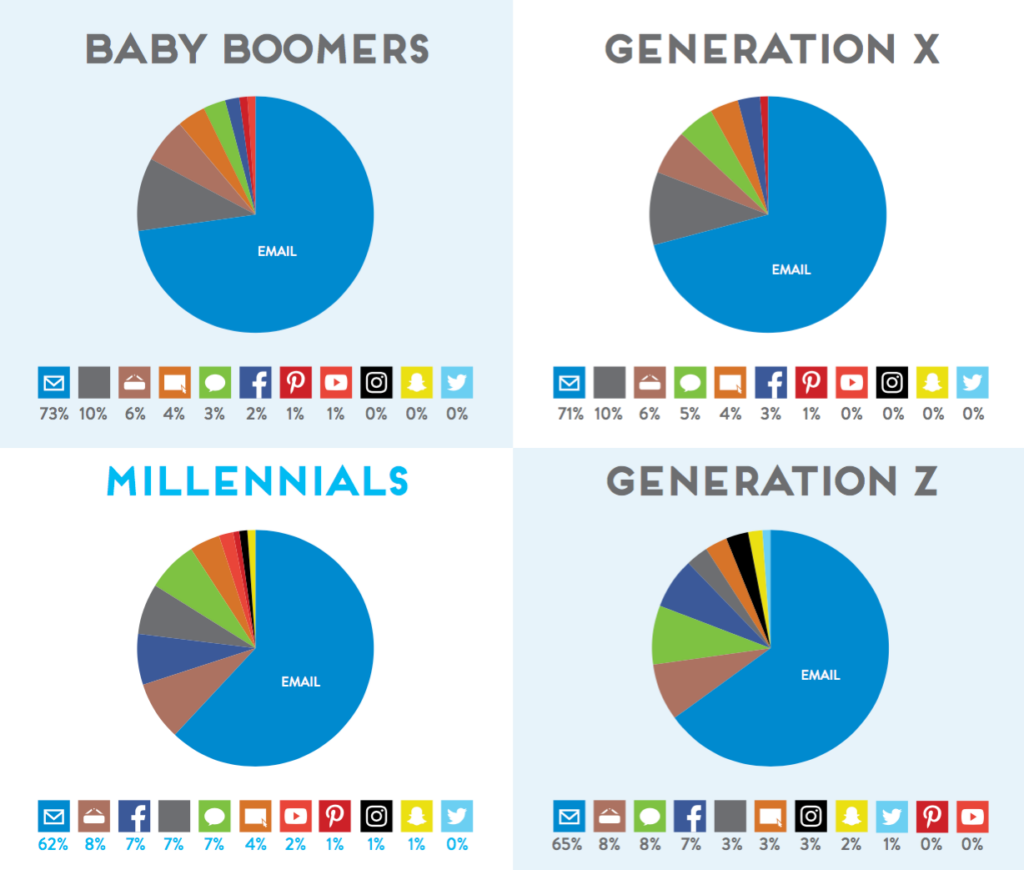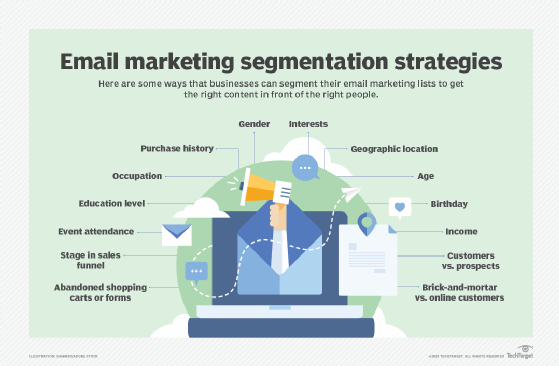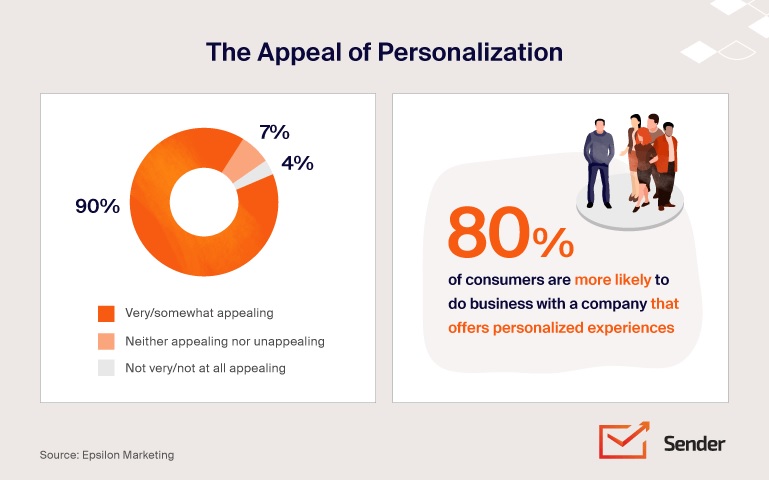Data Driven Email Marketing: The Definitive Guide
Despite the notoriously overcrowded inboxes most people deal with today, they still overwhelmingly prefer to communicate through email—especially in business environments. Having a data-driven email marketing strategy, then, that reaches the right audiences at the right time, is essential.
Data-driven email marketing enables businesses to meet modern buyer expectations for highly tailored and relevant communication, and it helps marketing teams nurture leads more effectively down the pipeline toward final purchase. Even better, it delivers insight back to your team so that you can use it to continually optimize your strategy for better results.
In this guide, we’ll cover everything you need to know about data-driven marketing, which metrics you should measure, and how to implement a strategy that delivers.
Quick Takeaways:
- Email is the most-preferred method for brand communication across all consumer generations.
- Important email metrics to measure include: open rate, click-through rate, conversion rate, bounce rate, unsubscribe rate, and spam complaint rate.
- List segmentation and message personalization increase email campaign effectiveness.
- Data-driven email marketing never stands still; It requires continual monitoring, improvement, and adjustments as trends and preferences evolve.
Why Does Email Marketing Need to Be Data-Driven?
Email remains the most reliable and customer-preferred method of digital brand communication. It wins over other channels by far and across all generations of professionals, from Boomers through to Gen X.

But the reality is that email inboxes are crowded. The average professional sorts through more than 100 emails every day, and generic messages simply won’t grab anyone’s attention. Instead, they’ll get deleted before recipients even know what they’re about.
To get noticed, and even more importantly, to earn engagement, companies need data-driven email marketing. Why? Because it enables marketing teams to craft email strategies that are personalized and targeted to specific audience segments and even individual prospects or customers.
Further, data allows marketers to continually monitor and analyze the effectiveness of email campaigns, and make adjustments in near real-time so results can be optimized.
7 Key Metrics for Data-Driven Email Marketers
To monitor email performance, it’s critical to know and incorporate the most important data-driven KPIs and metrics into your reporting process. These include:
Open Rate
Open rate measures the percentage of recipients who open an email message. For marketers, it’s crucial because it helps gauge the effectiveness of message targeting as well as other first-impression aspects of the email, like subject lines and sender name.
Click Through Rate
Click through rate (CTR) measures the percentage of email recipients who click on a link within the email, either to view/read content or take further action as outlined in the email’s CTA. Click through rate is generally considered a direct reflection of the email’s content relevance and effectiveness in engaging its target audience.
Conversion Rate
Email conversion rate captures the percentage of recipients who actually complete the desired action after clicking through in an email, such as making a purchase or registering for an event. For marketers, this is a top indicator of how well email is driving true lead nurturing and pipeline movement.
Bounce Rate
By measuring the percentage of sent emails that couldn’t be delivered, the bounce rate helps identify potential issues with the email list’s quality. A high bounce rate can indicate outdated or incorrect email addresses and can affect your reputation as the sender reputation.
Unsubscribe Rate
This is the rate at which recipients opt out of future emails. For marketers, a rising unsubscribe rate is a red flag signaling issues with email frequency, content relevance, or audience targeting—all of which can impact whether recipients enjoy receiving your emails or want to hear from your brand at all.
Spam Complaint Rate
Most major email service providers (like Gmail, Yahoo, Outlook) communicate with email marketing platforms through feedback loops to indicate when recipients mark an email as spam. It’s important for marketers to monitor spam complaints because a high complaint rate can signal to email service providers that there are issues with the relevance and quality of your emails.
Consistently high or rapidly increasing spam rates can lead to further flagging and even get companies blocked from sending further emails, a problem that must be avoided at all costs.
It’s important to note that no single metric on this list (or otherwise used by marketers) can provide a complete picture of email marketing effectiveness. Data-driven email marketing requires monitoring a strategic combination of key metrics to maintain a holistic understanding of performance.
Let’s take a deeper dive into how exactly data-driven email marketing should be implemented and how to incorporate these key metrics most impactfully to drive results.
How to Implement Data-Driven Email Marketing
1. Collect and Integrate Data
The foundation of data-driven email marketing lies in collecting accurate data. Adopt a centralized data management system (for example: a CRM system) and integrate it with your email marketing platform for a seamless flow of customer data across internal systems, and so that data is automatically updated, accurate, and consistent when used in email campaigns.
2. Segment Email Lists
We know that generic emails don’t get noticed by today’s business audiences. To grab their attention, you need a more personalized approach. Segmenting your email lists by shared attributes enables you to ensure every email message you send is hyper-relevant for its recipients.
For example: You might segment a list by demographic attributes, like location, or business attributes, like industry or area of expertise. Alternatively, you might use behavioral segmentation strategies, like creating a list of recipients who have attended past events or downloaded certain content.
Here are some other ideas for segmenting email lists:

The benefit of modern email marketing tools is that you can do all this rather easily as long as you have step one—solid data collection processes—already in place.
3. Personalize Email Messages
A personalized email is more than just addressing the recipient by name. Use data to go deeper and tailor content based on a recipient’s behavior, past interactions, and preferences to significantly increase the chance of engagement.
Truly personal touches, from personalized product recommendations to dynamic content customized for individual recipients (or groups), make emails stand out. In fact, 90% of consumers say personalization is appealing for them, and 80% are more likely to do business with a company that offers personalized experiences.

4. Test and Optimize
Good data-driven email marketing never rests on its laurels. Perform regular A/B testing of your email content, from subject lines to CTAs, to help identify what’s resonating with your audience and eliminate what isn’t.
Using A/B testing insights, you can continually refine your approach and evolve your strategy so that your email content never gets stale or out of touch with new preferences and trends.
5. Implement Automated Email Campaigns
Automation is what allows companies to execute email marketing at scale, and it’s a key part of any good data-driven strategy. Automate drip campaigns and behavior-triggered emails to send timely content and capture the interest of prospects and customers while intent is high.
By setting up systems that recognize and act on user interactions, you increase the likelihood your emails will drive desired actions.
6. Leverage Feedback Loops to Improve
Recipient feedback is your most direct and accurate source of insight about your email marketing effectiveness. Incorporate simple feedback loops into your email messages (it can be a very simple rating scale, like the example below) and use the insights to improve.

Periodically, and especially with highly engaged audiences, you can send out longer surveys and ask for more extensive feedback, both on your emails and other important topics related to your business.
7. Stay Updated with Compliance Regulations
With data comes responsibility. Ensure that your data-driven email marketing practices comply with regulations like GDPR or CAN-SPAM. As these standards evolve, so should your practices, ensuring you’re always aligned with laws and regulations, thus building trust with your recipients and partners.
8. Analyze and Report on Data Metrics
The “data-driven” part of data-driven marketing isn’t a one-off task—it’s continuous. Regularly monitor the key metrics we covered earlier in this article, and implement a reporting process to share insights with important members of your team. Actively tracking data metrics provides actionable insight that can guide your future strategies and campaigns in an objective, reliable way.
9. Outsource When You Need Support
As you can tell, executing a data-driven email marketing strategy requires significant time, resources, and expertise. For this reason, many companies choose to outsource to an email marketing company. If you feel like you can’t execute a quality strategy internally, your best option is to find a service provider who can. Almost always, the added ROI you’ll get from outsourcing far outweighs the initial cost.
Over to You
Now you know exactly what it takes to implement a data-driven email marketing strategy that will deliver results.And if you need support, Televerde is here to help.
Our industry-leading marketing, sales, and customer experience solutions help companies in all industries connect with their target audiences and win more sales. Get in touch with our team to learn more about how we can help your business grow.


